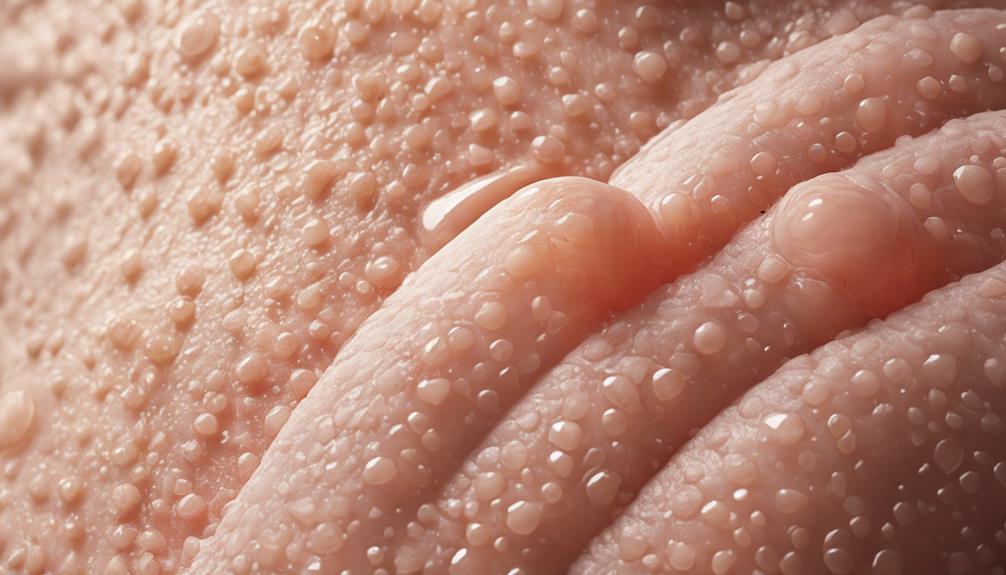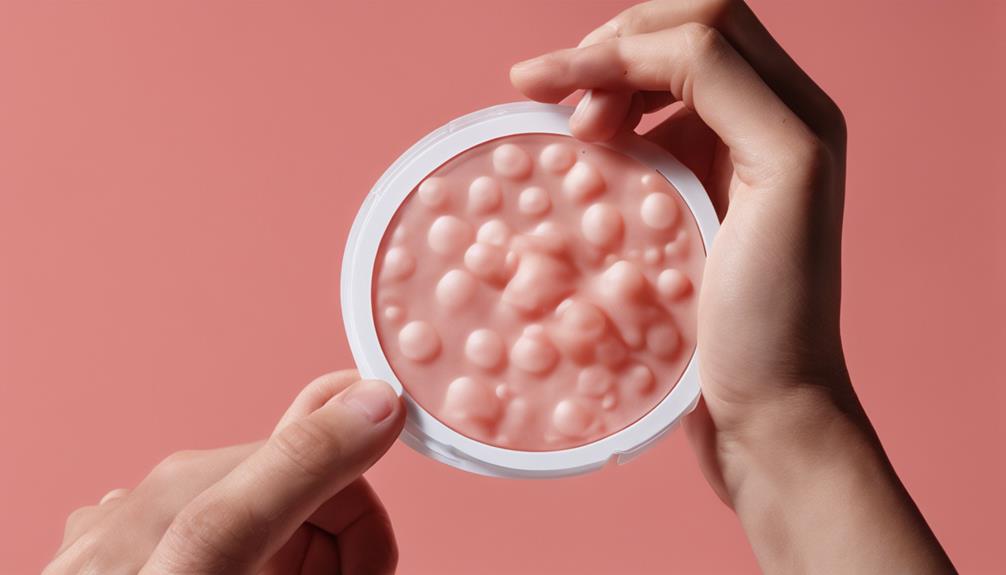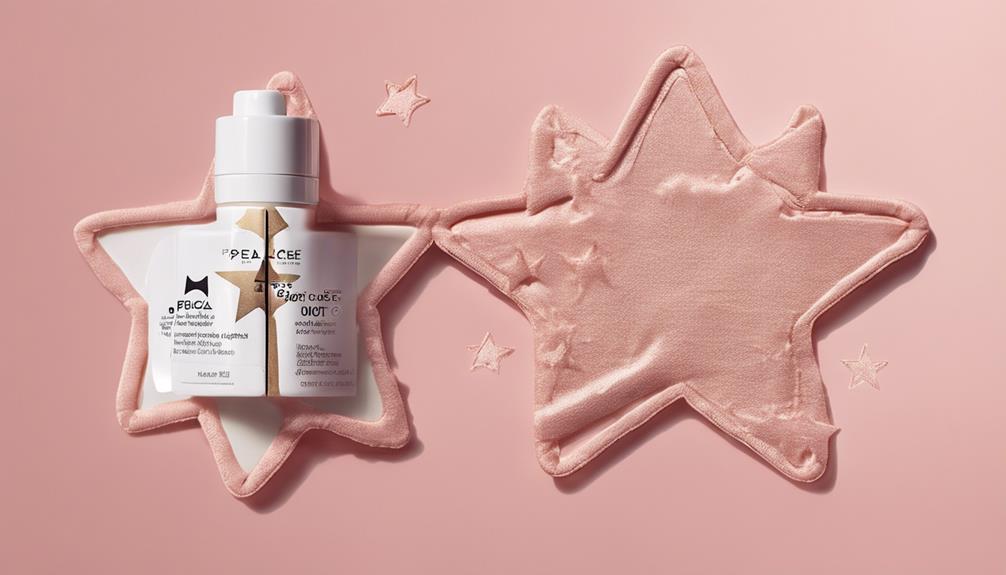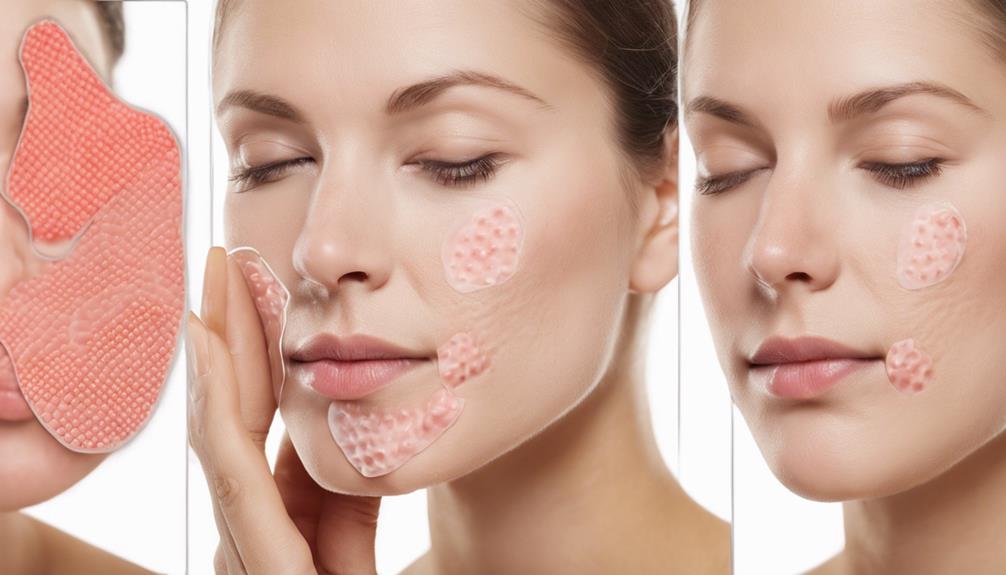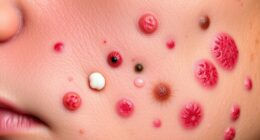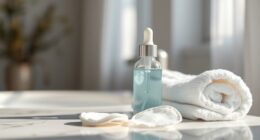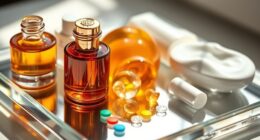Pimple patches function by absorbing impurities and fluids, creating a barrier against bacteria, promoting healing, and reducing redness and inflammation. The hydrocolloid material within the patches draws out oil and pus while forming a protective shield. This moist environment supports quicker skin recovery and discourages picking, helping with stress relief. By managing oiliness and preventing additional infection, these patches aid in achieving a clearer complexion. If you wish to learn more about their functions and benefits, delving into how they absorb impurities and retain moisture can offer a better understanding of their effectiveness. In addition to their absorptive properties, pimple patches are often infused with active ingredients like salicylic acid or tea tree oil, which can further enhance their effectiveness in treating acne. Understanding how pimple patches treat blemishes reveals their ability not only to manage existing breakouts but also to prevent future ones by keeping the affected area clean and moisturized. Ultimately, incorporating these patches into your skincare routine can lead to a more balanced and healthier complexion.
Key Takeaways
- Hydrocolloid material absorbs impurities and fluids from pimples.
- Creates a moist healing environment and seals off bacteria.
- Acts as a barrier against infection and minimizes scarring risk.
- Discourages skin picking and promotes healthy healing.
- Reduces redness, oiliness, and inflammation in pimples.
How Pimple Patches Absorb Impurities
How do pimple patches effectively absorb impurities like oil, bacteria, and pus?
Pimple patches work wonders through the hydrocolloid material they contain. This special substance has the essential ability to absorb impurities and draw out fluids from the pimple, forming a gel-like substance.
By creating a moist environment over the affected area, these patches facilitate fast healing. As the patch turns white, it signals the absorption process is in full swing, ensuring you can see the effectiveness right before your eyes.
Additionally, by sealing off the pimple from external bacteria, these patches not only aid in preventing further infection but also promote a clean healing process. This sealing action is vital for maintaining a barrier that supports the skin's natural healing mechanisms.
The Gel Formation Process

When hydrocolloid patches come into contact with a pimple, they begin a gel formation process that draws out impurities and fluids. This mechanism helps in flattening the pimple and promoting the skin's healing process.
As the hydrocolloid patch absorbs oils and pus, it turns white, indicating that it's actively working to treat the affected area.
Gel Formation Mechanism
Upon contact with fluids from a pimple, pimple patches undergo a gel formation process that aids in drawing out impurities, oil, and bacteria. This gel-like consistency not only helps in oil absorption but also promotes bacteria removal, creating a barrier that seals the pimple from external contaminants.
As the patch absorbs the fluids, it turns white or opaque, indicating the removal of impurities. By creating this protective seal, the patch supports the healing process, reducing the risk of infection. This mechanism guarantees that the pimple stays clean and isolated, allowing for faster recovery.
The gel formation within the patch plays an important role in maintaining a conducive environment for the skin to heal efficiently.
Absorption of Impurities
In the gel formation process of pimple patches, impurities like oil, bacteria, and pus are effectively absorbed, creating a protective barrier that seals the pimple from external bacteria. The hydrocolloid material in the patch traps these impurities, forming a gel that not only absorbs but also helps prevent further contamination.
This barrier plays an essential role in the healing process of the pimple by keeping external bacteria at bay. By sealing off the pimple, the patch promotes faster healing and reduces the risk of infection. As the hydrocolloid material absorbs impurities, it changes color, indicating its effectiveness in drawing out impurities and facilitating the healing process.
Using these patches can aid in maintaining clear and healthy skin.
Skin Healing Process
During the skin healing process, the gel formation in pimple patches actively absorbs fluids like oil, bacteria, and pus to create an ideal environment for recovery. As the patch absorbs these impurities, it turns white and forms a gel-like substance, sealing the pimple from external bacteria. This process not only helps prevent infection but also promotes healing by maintaining a clean and protected environment.
Additionally, by covering the pimple, the patch helps prevent touching or picking at the affected area, further aiding in the skin's recovery. The gel-like substance created by the patch aids in the absorption of fluids, allowing the skin to heal faster and reducing the risk of scarring.
Barrier Against Bacteria
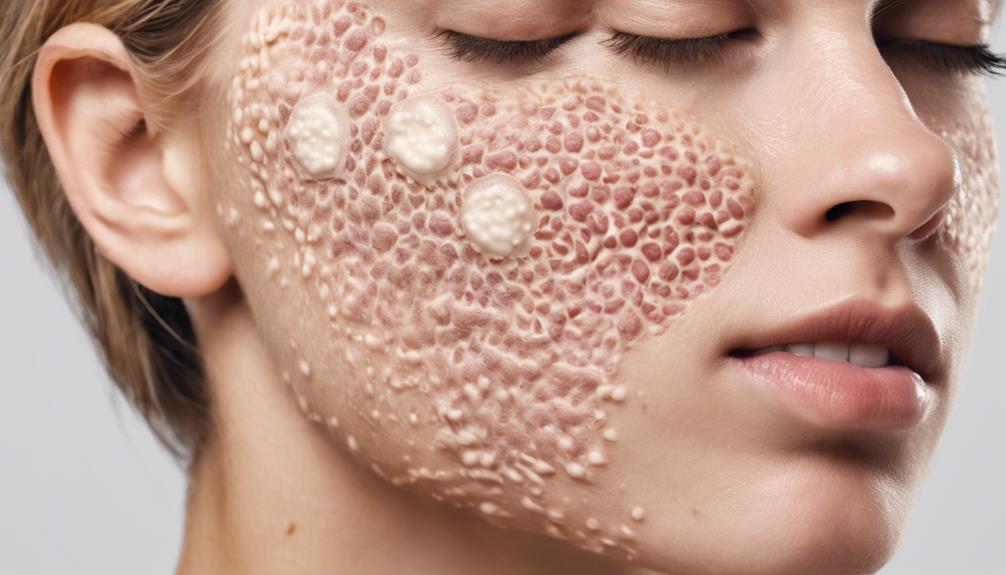
Creating a protective shield, pimple patches act as a barrier against bacteria to safeguard the pimple from external contaminants. This barrier plays an important role in protecting the pimple and creating a healing environment by preventing harmful microbes from causing further infection, inflammation, or scarring.
- Pimple patches block out bacteria, reducing the risk of infection.
- The sealed outer layer of the patch protects the pimple from external contaminants.
- By acting as a shield against harmful microbes, pimple patches promote a cleaner and safer environment for healing.
- This protective barrier helps minimize the risk of scarring and maintains a barrier against external factors that could hinder the healing process.
With these functions, pimple patches not only protect the affected area from harmful elements but also create a conducive environment for the pimple to heal effectively.
Preventing Skin Picking
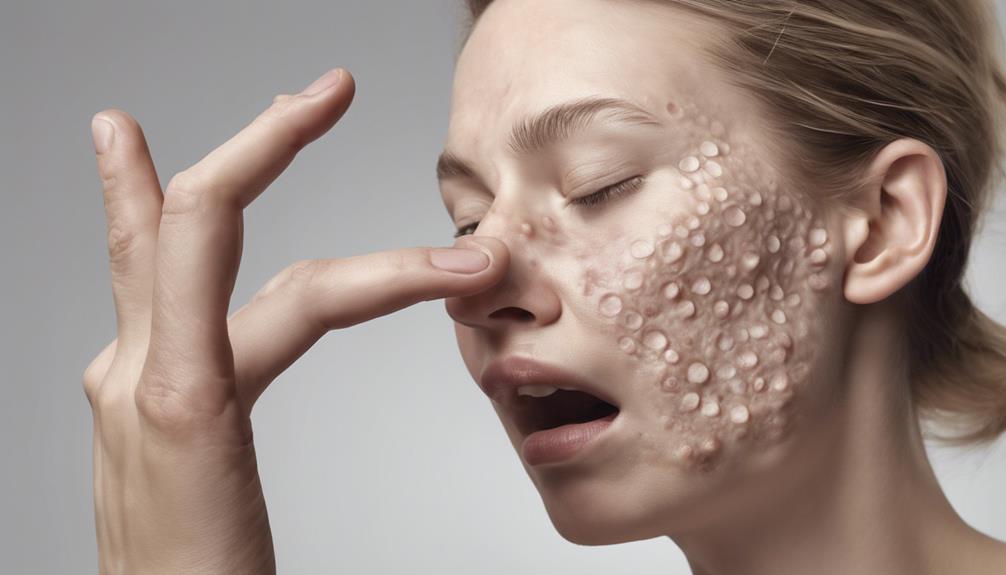
Skin picking can exacerbate acne by spreading bacteria and causing inflammation. Instead of picking, consider using pimple patches as a stress-free alternative to prevent skin damage.
These patches can serve as a healthy coping strategy to avoid the temptation of touching and picking at pimples.
Skin Picking Triggers
To prevent skin picking, individuals can utilize pimple patches as a physical barrier against the temptation to touch or pick at acne blemishes. When it comes to skin picking triggers, there are several key points to take into account:
- Dermatillomania, also known as skin picking, can worsen acne and delay healing.
- Pimple patches act as a physical barrier, reducing the temptation to pick or touch the skin.
- Covering the pimple with a patch discourages behaviors that may lead to scarring and prolonged healing.
- Patches create a protective layer, minimizing the risk of introducing bacteria from fingers or nails, which can exacerbate the condition.
Alternative Stress Relief
When faced with the urge to pick at acne blemishes due to stress, utilizing pimple patches can provide a beneficial alternative stress relief method.
Pimple patches act as a physical barrier, preventing skin picking and touching the pimple, which can reduce anxiety and promote healing. By covering the blemish, these patches deter the urge to pick or squeeze, helping to prevent scarring and further breakouts.
They offer protection and containment for the pimple, creating a hands-off approach that manages stress-related skin picking behaviors. This containment helps break the cycle of stress-induced skin picking, allowing the blemish to heal naturally and promoting overall skin health.
Pimple patches serve as a helpful tool in managing stress and anxiety while supporting the skin's healing process.
Healthy Coping Strategies
How can individuals effectively prevent the detrimental habit of picking at their skin, especially when dealing with stress-induced acne flare-ups? One way to combat skin picking is by incorporating healthy coping strategies like using pimple patches. Here are some tips to prevent skin picking:
- Utilize pimple patches: These act as a physical barrier, reducing the temptation to touch or pick at pimples, aiding in faster healing.
- Avoid introducing bacteria: Skin picking can introduce bacteria, causing infections and delaying the healing process, making pimple patches a valuable tool.
- Promote proper healing: Pimple patches help break the habit of skin picking by providing a protective layer over the blemish, promoting proper healing.
- Develop healthier habits: Incorporating pimple patches into your skincare routine can promote healthier habits and prevent further skin damage from picking.
Healing Environment Creation
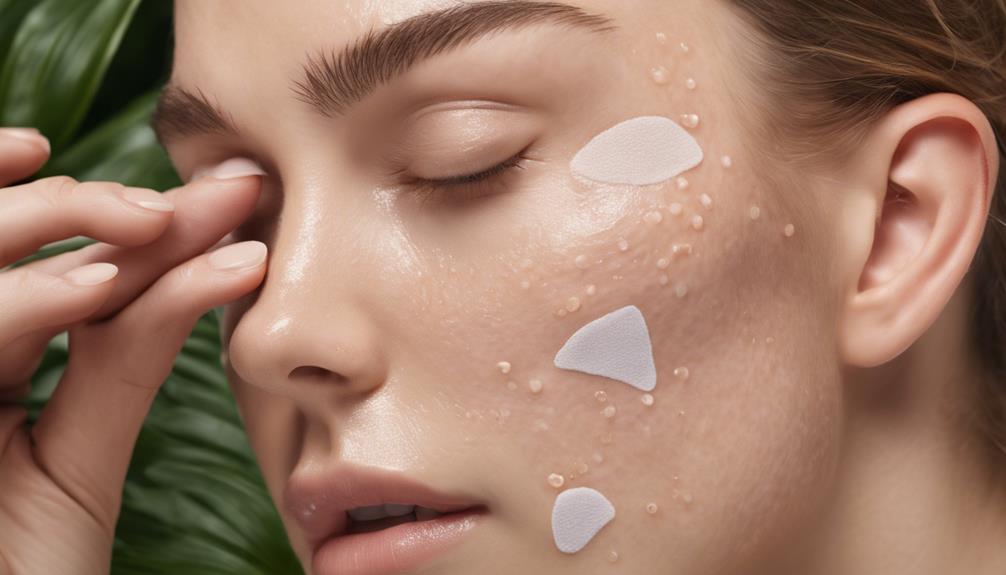
Creating an ideal healing environment is essential for effective pimple patch treatment. Hydrocolloid patches play a significant role in this process by absorbing pimple fluid, including oil, bacteria, and pus. These patches, designed to heal, seal the affected area, and prevent further infection. The moist environment they maintain aids in faster healing, particularly for pimples that have already discharged fluid. By forming a gel that turns white upon absorbing fluids, the outer layer effectively seals the pimple from harmful bacteria. Here is a table highlighting the key functions of hydrocolloid patches:
| Function | Description |
|---|---|
| Absorb Pimple Fluid | Helps in drawing out oil, bacteria, and pus from the skin. |
| Seal Pimple | Forms a protective barrier over the pimple, preventing bacterial infection. |
| Maintain Moisture | Creates a moist environment that supports faster healing of the skin. |
Hydrocolloid patches not only aid in the healing process but also reduce the risk of infection, contributing to a clearer and healthier complexion.
Reducing Redness and Oil
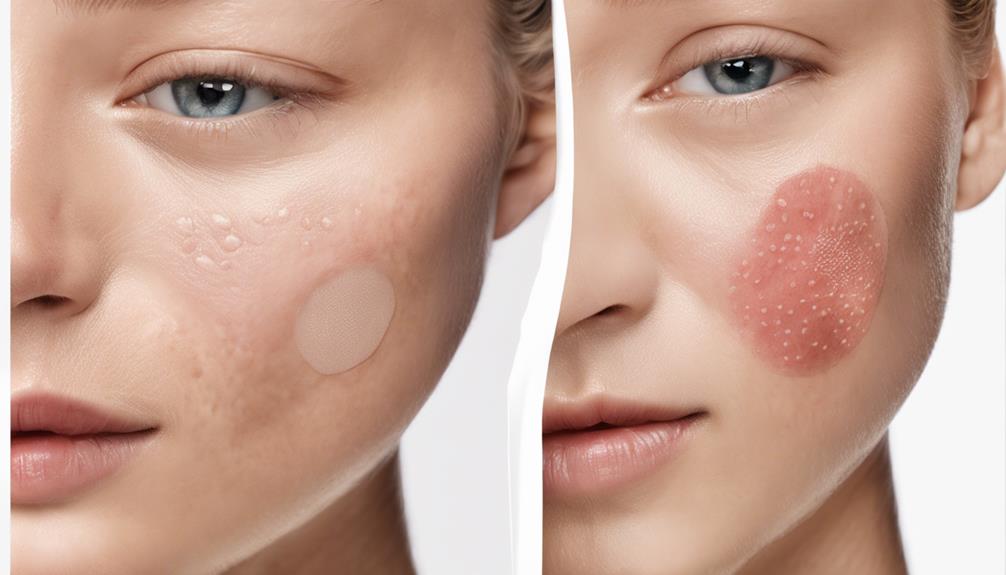
Using a hydrocolloid pimple patch can effectively reduce redness and control oiliness in pimples. These patches create a protective barrier that seals the pimple from external bacteria, reducing the risk of infection.
The hydrocolloid material present in the patches absorbs excess oil and pus, promoting a cleaner environment for the pimple to heal. They're specifically designed to absorb sebum, helping to control oiliness and prevent further pore blockage.
Additionally, pimple patches can visibly reduce redness and inflammation in pimples, making them less noticeable over time. By absorbing excess oil, these patches also aid in controlling shine and maintaining a matte appearance on the skin, offering a solution for those looking to manage oily skin effectively.
Frequently Asked Questions
Do Pimple Patches Work on Unpopped Pimples?
Yes, pimple patches are effective on unpopped pimples. They create a protective barrier, prevent picking, and absorb oil and impurities.
The hydrocolloid material inside promotes faster healing. These patches reduce redness and inflammation while aiding in the healing process.
Why Do Pimple Patches Turn White?
When pimple patches turn white, it's a sign that they're actively absorbing oils, bacteria, and pus from the blemish. The white color indicates that the patch is drawing out impurities and creating a moist environment for healing.
The gel-forming material in hydrocolloid patches reacts with the absorbed contents, causing the color change. This visual indicator shows that the patch is working to extract and trap impurities, helping to remove excess oil and promote blemish recovery.
Do Acne Patches Actually Work?
Acne patches can indeed work wonders! They help create a healing environment by absorbing oil, bacteria, and pus from pimples. When used alongside other topical solutions, they enhance penetration for better results.
These patches are gentler on the skin compared to some harsh topical treatments, promoting faster healing. Hydrocolloid patches, especially when used on popped pimples, create a moist environment that aids in skin recovery.
What Do Pimple Patches Draw Out?
Pimple patches draw out excess oil, bacteria, and pus from within the pimple. They create a barrier to seal the pimple, blocking external contaminants. The patches turn white or opaque as they absorb fluids, indicating their effectiveness.
Hydrocolloid patches are designed to draw out impurities while maintaining a moist environment for healing. They aid in reducing inflammation, redness, and the overall appearance of the pimple by extracting impurities.
Conclusion
To sum up, pimple patches work by:
- Absorbing impurities
- Forming a gel barrier against bacteria
- Preventing skin picking
- Creating a healing environment
- Reducing redness and oil
As the saying goes, 'a stitch in time saves nine.' These small patches may seem simple, but their effectiveness in treating pimples is backed by science.
So next time you have a pesky pimple, consider using a pimple patch to help clear it up quickly and effectively.
